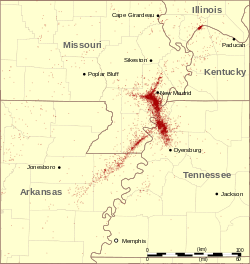Intraplate earthquake
The term intraplate earthquake refers to a variety of earthquake that occurs within the interior of a tectonic plate; this stands in contrast to an interplate earthquake, which occurs at the boundary of a tectonic plate.
| Part of a series on |
| Earthquakes |
|---|
|
Characteristics |
|

Intraplate earthquakes are relatively rare compared to the more familiar boundary-located interplate earthquakes. Therefore, large intraplate earthquakes can inflict heavy damage with such areas' structures lacking seismic retrofitting. Examples of damaging intraplate earthquakes are the devastating Gujarat earthquake in 2001, the 2012 Indian Ocean earthquakes, the 2017 Puebla earthquake, the 1811–1812 earthquakes in New Madrid, Missouri, and the 1886 earthquake in Charleston, South Carolina.[1]
Fault zones within tectonic plates
The surface of the Earth is made up of seven primary and eight secondary tectonic plates, plus dozens of tertiary microplates. The large plates move very slowly, owing to convection currents within the mantle below the crust. Because they do not all move in the same direction, plates often directly collide or move laterally along each other, a tectonic environment that makes earthquakes frequent. Relatively few earthquakes occur in intraplate environments; most occur on faults near plate margins.
By definition, intraplate earthquakes do not occur near plate boundaries, but along faults in the normally stable interior of plates.[2] These earthquakes often occur at the location of ancient failed rifts, because such old structures may present a weakness in the crust where it can easily slip to accommodate regional tectonic strain.
Compared to earthquakes near plate boundaries, intraplate earthquakes are not well understood, and the hazards associated with them may be difficult to quantify.
Examples
Examples of intraplate earthquakes include those in Mineral, Virginia in 2011 (estimated magnitude 5.8), New Madrid in 1811 and 1812 (estimated magnitude as high as 8.1)[3], the Boston (Cape Ann) earthquake of 1755 (estimated magnitude 6.0 to 6.3), earthquakes felt in New York City in 1737 and 1884 (both quakes estimated at about 5.5 magnitude), and the Charleston earthquake in South Carolina in 1886 (estimated magnitude 6.5 to 7.3). The Charleston quake was particularly surprising because, unlike Boston and New York, the area had almost no history of even minor earthquakes.
In 2001, a large intraplate earthquake devastated the region of Gujarat, India. The earthquake occurred far from any plate boundaries, which meant the region above the epicenter was unprepared for earthquakes. In particular, the Kutch district suffered tremendous damage, where the death toll was over 12,000 and the total death toll was higher than 20,000.
In 2017, the 24–29 km deep magnitude 6.5 Botswana earthquake that shook eastern Botswana occurred at over 300 km from the nearest active plate boundary.[4] The event occurred in an underpopulated area of Botswana.
The 1888 earthquake in Río de la Plata was also an intraplate quake.[5]
Causes
Many cities live with the seismic risk of a rare, large intraplate earthquake. The cause of these earthquakes is often uncertain. In many cases, the causative fault is deeply buried,[4] and sometimes cannot even be found. Some studies have shown that it can be caused by fluids moving up the crust along ancient fault zones.[4][6] Under these circumstances it is difficult to calculate the exact seismic hazard for a given city, especially if there was only one earthquake in historical times. Some progress is being made in understanding the fault mechanics driving these earthquakes.
Intraplate earthquakes may be unrelated to ancient fault zones and instead caused by deglaciation or erosion.[7]
Prediction
Scientists continue to search for the causes of these earthquakes, and especially for some indication of how often they recur. The best success has come with detailed micro-seismic monitoring, involving dense arrays of seismometers. In this manner, very small earthquakes associated with a causative fault can be located with great accuracy, and in most cases these line up in patterns consistent with faulting. Cryoseisms can sometimes be mistaken for intraplate earthquakes.
See also
- New Madrid Seismic Zone – Major seismic zone in the southern and midwestern United States
- Saint Lawrence rift system – A seismically active zone paralleling the Saint Lawrence River
References
- Hough, Susan E.; Seeber, Leonardo; Armbruster, John G. (October 2003). "Intraplate Triggered Earthquakes: Observations and Interpretation". Bulletin of the Seismological Society of America. Seismological Society of America. 101 (3): 2212–2221. Bibcode:2003BuSSA..93.2212H. CiteSeerX 10.1.1.189.5055. doi:10.1785/0120020055.
- Yang, Xiaotao (2014). "Seismicity of the Ste. Genevieve Seismic Zone based on Observations from the EarthScope OIINK Flexible Array". Seismological Research Letters. 85 (6): 1285–1294. doi:10.1785/0220140079.
- Penick, James L. The New Madrid Earthquakes. Columbia, MO: University of Missouri Press, 1981. ISBN 0-8262-0344-2
- Kolawole, F.; Atekwana, E. A.; Malloy, S.; Stamps, D. S.; Grandin, R.; Abdelsalam, M. G.; Leseane, K.; Shemang, E. M. (2017-09-09). "Aeromagnetic, gravity, and Differential Interferometric Synthetic Aperture Radar analyses reveal the causative fault of the 3 April 2017 Mw6.5 Moiyabana, Botswana, earthquake". Geophysical Research Letters. 44 (17): 8837–8846. Bibcode:2017GeoRL..44.8837K. doi:10.1002/2017gl074620. ISSN 0094-8276.
- Benavídes Sosa, Alberto (1998). "Seismicidad y seismotectónica en Uruguay". Física de la Tierra (in Spanish) (10): 167–186.
- Gardonio, B.; Jolivet, R.; Calais, E.; Leclère, H. (2018-07-13). "The April 2017 Mw6.5 Botswana Earthquake: An Intraplate Event Triggered by Deep Fluids" (PDF). Geophysical Research Letters. 45 (17): 8886–8896. Bibcode:2018GeoRL..45.8886G. doi:10.1029/2018gl078297. ISSN 0094-8276.
- Shobe, Charlie (18 December 2018). "Can Rivers Cause Earthquakes?". Scientific American. Retrieved 26 December 2018.
Further reading
- Stein, S., and S. Mazzotti (2007). "Continental Intraplate Earthquakes: Science and Policy Issues", Geological Society of America, Special Paper 425.